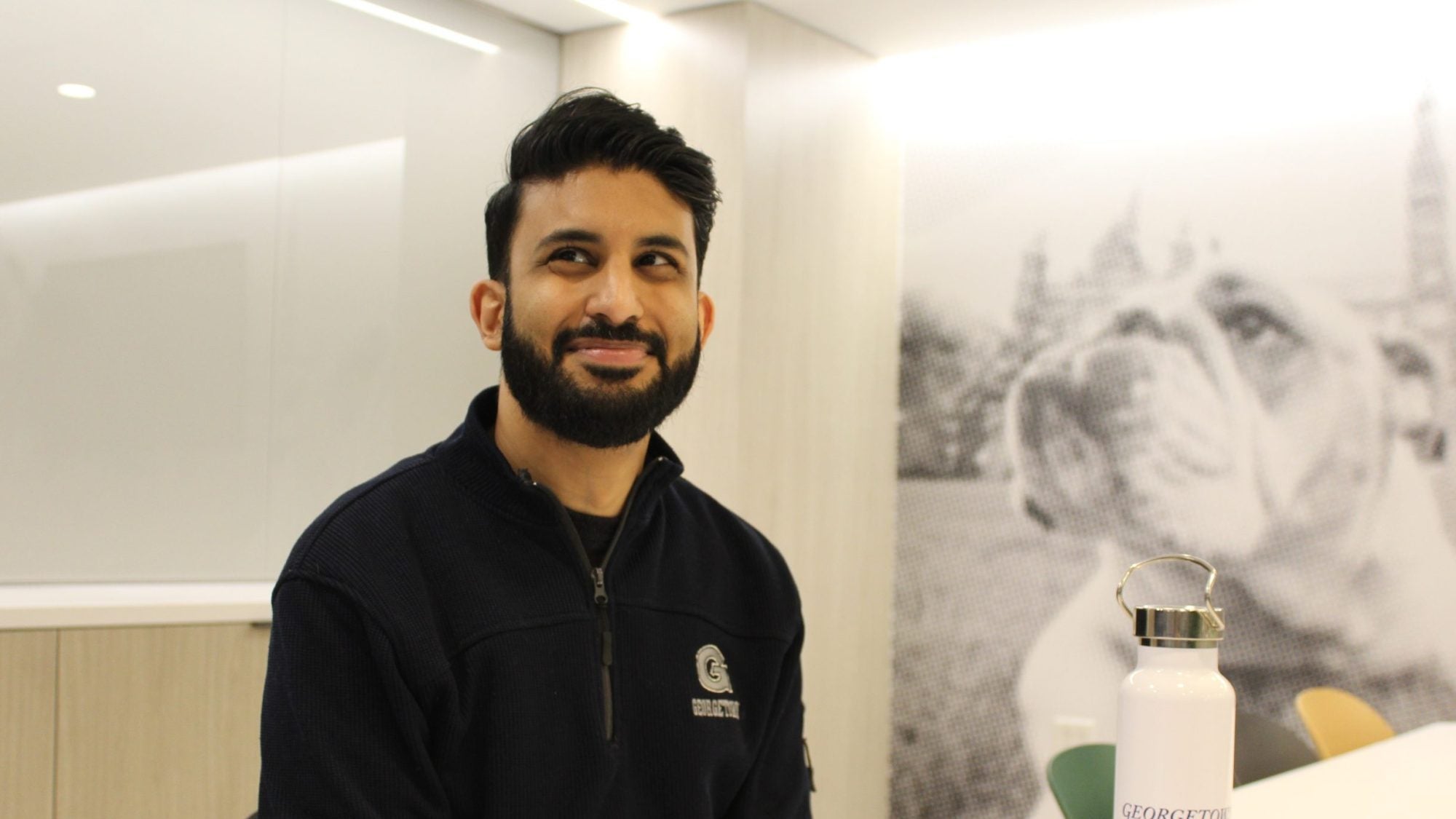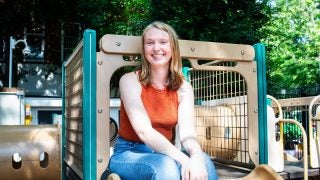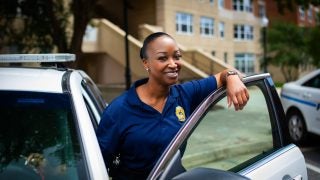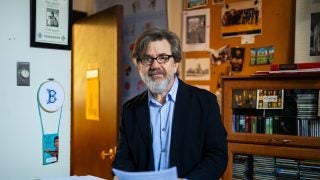This story is part of Georgetown Faces, a storytelling series that celebrates the beloved figures, unsung heroes and dedicated Hoyas who make our campus special.
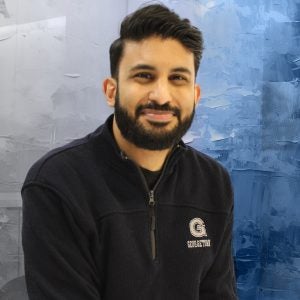
Anupam Chakravarty’s (SFS’10, G’14) career path began in an unlikely place: his high school rock band.
Chakravarty, the senior director of digital channel strategy in the Office of Advancement (OA), played bass guitar, and found his passion for design and communications while promoting the band.
“I made cover art for our demos,” he said. “I’d spend hours refining our Myspace presence and learning HTML.”
His parents nurtured his love of design and communications as a way of “unlocking something within people,” he said. And his mother, former associate dean in Media Studies at The New School in New York City, introduced him to design documentaries like Helvetica.
“Ever since, I’ve been drawn to how words and typefaces can express something else on top of the language itself,” he said.
In 2010, Chakravarty graduated from Georgetown’s School of Foreign Service, and in the years following, he helped develop OA’s digital strategy, earned his masters from the Communication, Culture & Technology (CCT) program, and married fellow Hoya, Constance Parham (SFS’10). Today, he applies his love of design and communications as the senior director of the digital channel strategy team within the OA communications department, where he works with staff and alumni to develop email strategy and Georgetown’s alumni digital media voice.
“I found my people when it came to Georgetown because of the emphasis on service.”
Chakravarty is also the staff co-chair of the Asian, Asian American, Pacific Islander (AAAPI) Employee Resource Group (ERG). He works closely with colleagues to empower AAAPI-identifying employees to create an inclusive working environment.
Chakravarty recently represented the ERG at the White House Initiative on Asian Americans, Native Hawaiians, and Pacific Islanders and the U.S. Office of Personnel Management’s leadership development summit for higher education leaders, administrators and faculty. He moderated a panel about the formation, struggles and opportunities related to starting and sustaining AAPI ERGs at universities.
“It is one of the most fulfilling things I’ve ever been a part of at Georgetown,” he says.
Learn more about how Anupam Chakravarty found his career path through activism and music, how he met his wife, and how he looks to create a better Georgetown and life through his work.
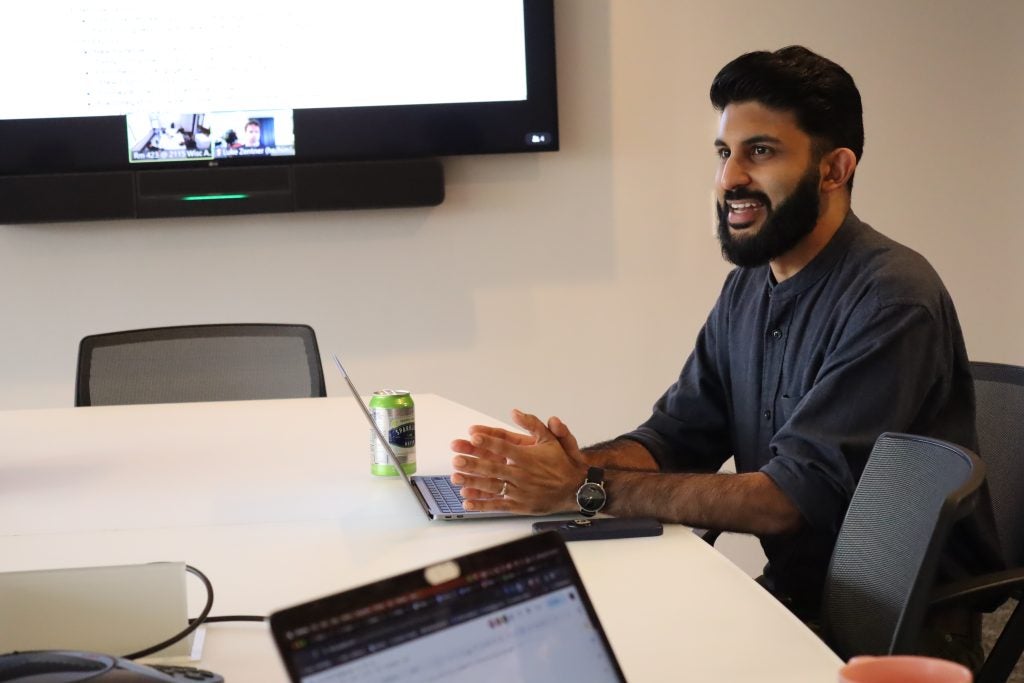
How I became interested in digital storytelling: It started with activism and music. I play bass guitar. I’ve been playing piano since I was little and I sang a lot in high school. In college I became a DJ and DJ’d every student club’s formal events. But in the process of making benefit concerts — and throwing big fundraiser parties for a cause — I discovered the importance of getting the word out through design. This was where art and activism and persuasion and community-building all came together for me.
My favorite class at Georgetown: I’m going to go with Ethnic War and Class Struggle taught by Elizabeth Andretta. It was my freshman pro seminar at the SFS. It was small, and it was my first taste of, ‘this is what college can be and how wide your mind can be ripped open.’ The class also tied in really well with my love of service.
My other favorite undergraduate class was Genocide Justice and Reconciliation taught by husband-and-wife duo Brian (SFS’94, L’97) and Jessica Kritz. They brought in incredible experiences from the field — being involved in international criminal tribunals and doing field work in Rwanda — to an engaging classroom.
I want to shout out my graduate thesis advisor Professor Leticia Bode. The Tech and Foreign Policy class that I took with her reached me and resonated with me.
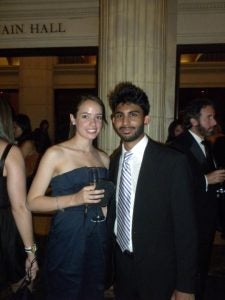
How I met my wife: It was our first class of freshman year: French at 8:50 in the morning in the ICC. We were sitting next to each other by chance, so we were French partners. We became friends through college and took classes together. She made me laugh. I just met my dream girl. I was like, ‘Oh, you’re sweet and smart and funny and beautiful, and in my French class, what is happening?’
We started dating about a year after graduating when Teach for America brought her to DC and this Georgetown job offer brought me to DC. I remember texting her — just my friend at the time, but a friend I probably was nursing a little crush on — so excited that I’d be in DC with her.
We got married in 2015, right across from Georgetown at the now defunct, sadly, Key Bridge Marriott, and we had a blended Scottish-Indian-Episcopalian-Hindu wedding. She’s the best person I know.
How my career at Georgetown began: I feel very fortunate. I was brought in, interviewed and hired on the spot. There was a concerted effort to recruit young alumni to work at Advancement because we have a built-in love and understanding of Georgetown that might help us succeed.
That love has felt mutual and reciprocated, especially as our workplace has evolved to be more flexible. We’re building the workplace we want to work in by taking mental health more seriously and trying to build community.
A big transformative moment at Georgetown: When my role shifted from building online media to a more specific focus on channel strategy. Focusing on social media and making email a priority changed my whole professional trajectory.
My role then shifted to how to govern a system. How do you bring people on board? How do you motivate staff around tasks that can be high-volume and repetitive, like email building? How do you build trust with alumni volunteers who do a lot of on-the-ground communication for us? I’ve learned a lot getting a CCT grad degree while working, and that built my confidence as a digital communications strategist.
Why I work with the AAAPI ERG: Being the staff co-chair of the AAPI ERG at Georgetown feels like a meaningful way to contribute to the community at this moment.
The ERG developed in conversation with the anti-Asian violence we saw leading up to, during and after the pandemic as well as anti-Asian violence I’ve personally experienced. I took the opportunity to hold Georgetown accountable for making a more equitable, inclusive workplace, where people could be their authentic selves and feel a sense of belonging.
We are in the early stages of making the space for employees now, bringing people together. Georgetown is so meaningful to me, and so, investigating and navigating my own culture and doing hard, vulnerable community-building work is important.
There’s a lot of volunteer energy involved in co-chairing this ERG and it’s for the greater good, but that’s a double-edged sword. We hope that if volunteers invest time into making the space first, eventually they will see the results in how our university pursues its equity and inclusion goals.
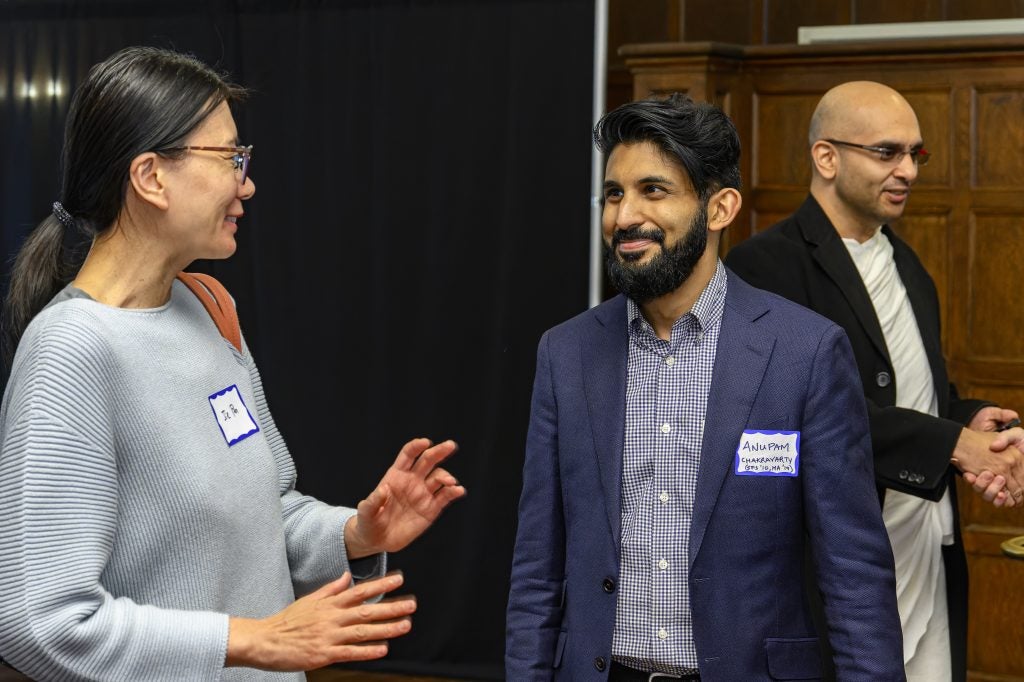
What inspires me: There’s a website called Seventeenpeople.com, which is this infographic-style illustration of The West Wing episode, “17 People.” I wrote my thesis for CCT on the White House and how race is imagined in the White House on television dramas, so I appreciate how they could nerd out in this passion project.
Also, two works of fiction made me a better person. Exhalation by Ted Chang taught me that you can create a world with very little. That sounds corny and cheesy, but what he does is just drop you into this sci-fi world, and it envelops you really quickly.
Around the same time, I read The Overstory by Richard Powers, and that book is the opposite. There were just so many stories, and it was long and layered, but the payoff was worth it.
If I could only play one song for the rest of my life: I would choose “Eat That Up, It’s Good for You” by Two Door Cinema Club. I saw them live at the 9:30 Club a long time ago with some close friends, one of whom passed away, so there’s a special memory with that. It has this beautiful, big instrumental swell in the middle that makes me always just look forward to it.
What I wish everyone knew about me and my role: I haven’t figured everything out and I haven’t taken anything off the table yet. I’m still discovering what I can do and how I can make the most impact. The last couple of years have been turned inward and local and present. I’ve had to be quieter, but I’m starting to find my voice again.
I want to be a more outspoken advocate on mental health, on DEI, on the importance of “care of the whole person” at Georgetown. I’ve earned a space at the table to bring questions about equity and inclusion, and again, about more comprehensive care of people.
Everything we do in digital communications requires a lot of thought. We genuinely, deeply care. I hope people know that. I hope they know that we’re really trying to push forward inclusion and help the university address some historic wrongs in little ways that hopefully, over time, move Georgetown in the right direction.
By Racquel Nassor. The first photo in the story is by Nowshin Chowdhury.
